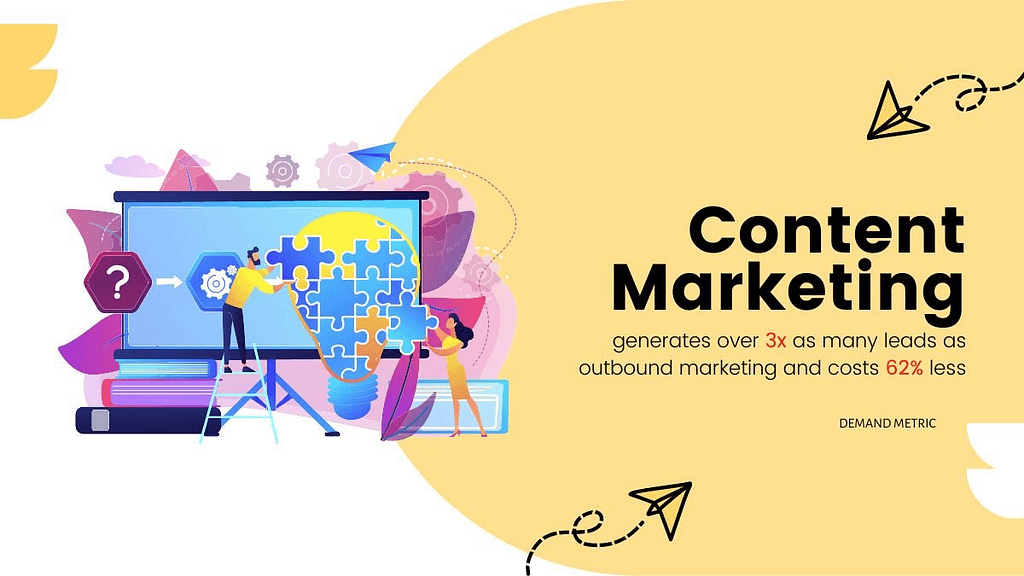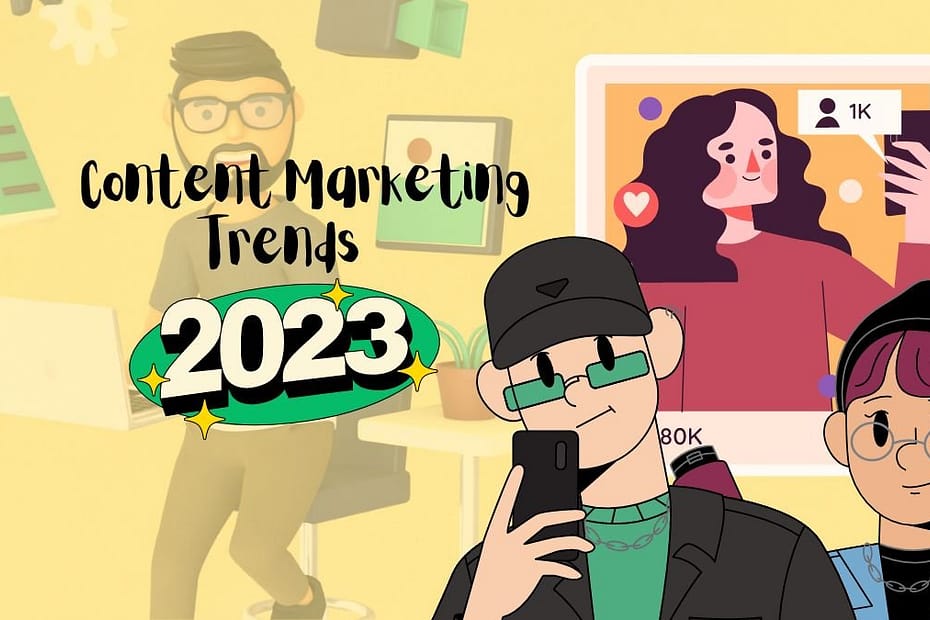You and I both know that staying up-to-date on the latest trends is crucial to staying ahead of the game. And when it comes to content marketing, things are no different!
Content marketing is a dynamic industry that keeps evolving continuously. Hence, it is extremely important for marketers, businesses, and content creators to stay up-to-date on the latest trends and techniques in order to create effective and successful content marketing campaigns.
A lot has changed in the content marketing industry throughout 2022, leading to the emergence of several new content marketing trends for 2023.
In this post, I will reveal the top content marketing trends set to take over in 2023 – and trust me, you won’t want to miss out on these valuable insights. From interactive and visual content to the power of personalization, the increasing use of AI and automation, here are some of the most progressive content marketing trends for 2023 that will help you stay ahead of the competition.
Keep reading to learn more!
“Content marketing is like a game of Tetris – sometimes you have to get creative to fit all the pieces together.“

Table of Contents
The Basics of Content Marketing for 2023
The recent advancements in Artificial Intelligence (AI) and Web3 technologies will definitely help content marketers to streamline their content creation workflow and fill in creative gaps quickly, effectively, and easily.
For instance, AI-powered tools can help with base-level tasks like keyword research, ideation, content scheduling, and even content creation. Likewise, Web3 technologies, especially the Metaverse, will unlock more creative opportunities to publish, promote, and monetize the content you create.
However, AI and Web3 technology can only help you if you (and your team) are willing to learn, experiment, and adapt. While this may require some upfront investment in training or resources, the long-term benefits outweigh the preliminary expenses and hard work.

Other than embracing these emerging tech-stacks, content marketers, businesses, and content creators will also need to update their existing approach to accessing and applying their audiences’ data. This is due in part to Google’s recent “helpful content” update, as well as the launch (and the upcoming deadline) for upgrading to Google Analytics 4.
To stay on top of these changes and make the most of the available data, content marketers will need to stay up-to-date on the latest trends and best practices in data collection and analysis.
More importantly, trends like vernacular content marketing will continue gaining traction this year. For instance, YouTube is already experimenting with a new feature that allows creators to add multilingual closed captions (CC) to their videos. This feature was introduced in response to the growing demand for accessible and multilingual content on the platform.
Now that we have settled the basics, let’s move on with the hottest content marketing trends for 2023.
Trend #1: The Need for Personalization and Targeting
One of the key trends in content marketing for 2023 is the increasing focus on personalization and targeting. With the proliferation of data and technology, it is now possible for businesses to create highly personalized and targeted campaigns that are specifically designed for individual customers or audience segments. This can be a powerful way to engage and convert potential customers, as it shows them that the business understands their needs and preferences.

To create personalized and targeted content, marketers can use data such as demographics, location, browsing history, and purchase history to create customized messages and offers.
For example, a clothing retailer might send personalized emails to customers based on their past purchases, recommending similar items or offering special discounts on items that the customer is likely to be interested in. This can be much more effective than a generic email blast, as it shows the customer that the business is paying attention to their individual needs and preferences.
Another example of personalization and targeting in action is personalized landing pages. Instead of sending all traffic to the same generic landing page, businesses can create customized pages for different audience segments or campaigns. This can help to increase conversions, as the page will be more relevant and targeted to the specific visitor.
Trend #2: More Video Content, Especially Short-Form Video
Video has become an increasingly important part of the content marketing landscape, as it allows businesses to engage and connect with their audience in a more visual and interactive way. This will remain unchanged in 2023!
To leverage videos in your content marketing efforts for 2023, you can use many different types of video content, including explainer videos, product demos, case studies, webinars, and live streams.
That said, bear in mind that short-form video content has surged in popularity in the last couple of years with mainstream platforms like Instagram, Tik Tok, and YouTube taking the center stage. Short-form video is a trend that is likely to continue to grow in popularity in 2023, as it allows businesses to connect with their audience in a fast-paced and visually appealing way.

There are several reasons why short-form video continues to grow in popularity. First, it is easy to consume, as it requires less time and attention from the viewer. This makes it well-suited for platforms where users are likely to be multitasking or have limited time to engage with content.
Second, short-form video is highly shareable, which can help to increase its reach and impact. Finally, it is relatively inexpensive and easy to produce, which makes it a good option for businesses with limited budgets or resources.
It doesn’t matter which type of video content you are creating till the time they are engaging. So, make sure to plan and script the content carefully, use high-quality visuals and audio, and consider the audience’s needs and interests.
To create effective short-form video content, it is important to keep the message and purpose of the video clear and concise, and to use visual and audio elements that are engaging and attention-grabbing. You may also want to consider the platform and audience when creating short-form video, as different platforms and audience segments may have different preferences and expectations.
Trend #3: Focus on Empathy and Human Experiences
Empathy and human-focused content is another key content marketing trends for 2023. In a world that is increasingly digital and disconnected, consumers are seeking out content that is authentic, relatable, and human.

So, by creating content that is focused on empathy and the human experience, businesses can build stronger connections with their customers and stand out in a crowded marketplace.
If you plan to create effective empathy and human-focused content, it is important to identify the audience’s needs and challenges, and to create content that speaks to those needs in a genuine and authentic way. It is also important to use language and imagery that is relatable and human, and to avoid using overly promotional or sales-focused language.
One way is to tell stories that are authentic and relatable, and that show the human side of the business or brand. This might include personal stories from the business owner or employees, customer stories, or behind-the-scenes looks at the business.
Another way is to create content that addresses real human needs or challenges and offers solutions or support. This might include educational content, resources, or guides that help customers to solve problems or make informed decisions.
Trend #4: The Rise of AI and Machine-Generated Content
Artificial intelligence (AI) is the hot topic these days! You can’t miss it, especially due to the influx of AI content and copy writing tools like Jasper, Rytr, Writesonic, and the most-recent ChatGPT by OpenAI.
AI and machine-generated content – be it in the form of text, images, or videos – have grown in popularity in 2022, and will continue disrupting the marketing landscape in 2023. Although it’s not a good idea to rely solely on AI to generate tons of content for your brand or business, these tools can definitely help you publish content more efficiently.

One of the key benefits of using AI and automation in content marketing is that it allows businesses to scale their efforts more effectively. By automating certain tasks, you can free up time and resources to focus on other aspects of your content marketing strategy.
Additionally, AI and automation can help businesses to create more personalized and targeted campaigns, as they can use data and algorithms to tailor messages and offers to specific audience segments.
From my perspective, AI content can be a useful tool for content marketers, but it is generally not advisable to solely rely on them. First, AI content may not always be accurate or dependable, and it may not always align with the business’s brand voice or messaging. Second, AI content may lack the authenticity and personality that is often important to building relationships with customers. Finally, AI content may not be able to capture the nuances and subtleties of language and communication that are important in marketing.
I would say that it is best for content marketers to use AI as a tool to assist with certain tasks. Using your own creativity and judgment alongside these tools will help you create more authentic and engaging content that resonates with your audience.
Trend #5: Interactive Content: AR, VR & The Metaverse
If you don’t already know, Augmented Reality (AR) and Virtual Reality (VR) are two of the strongest forces that are laying the foundation for a new era of content marketing. These technologies, alongside the new virtual playground – the Metaverse – have the potential to revolutionize the way that businesses create and deliver content and offer a number of exciting opportunities for content marketers.
Augmented reality (AR) is a technology that allows users to overlay digital content on top of the real world, using devices such as smartphones or tablets. AR can be used in a variety of ways in content marketing, such as creating interactive experiences, providing product demos or virtual try-ons, and enhancing print materials.

Likewise, Virtual reality (VR) is a technology that allows users to fully immerse themselves in a digital environment, using devices such as VR headsets or controllers. VR can be used in content marketing to create immersive and interactive experiences, such as virtual tours, product demos, or training simulations.
The point is: interactive content is a fast-growing trend. In fact, interactive content has been around for quite some time. Earlier versions of interactive content revolved around quizzes, surveys, and polls.
But with the emergence of AR, VR, and the Metaverse, immersive and interactive content has received a major upgrade, now expanding to virtual worlds, games, simulations, and non-fungible tokens (NFTs).
Trend #6: Accumulate and Utilize User-Generated Content
Everyone loves user-generated content (UGC) – content that is created by users or customers, rather than by the business or brand.

User-generated content is becoming increasingly important for businesses because it is authentic, trusted, and often more engaging than content that is created by the business itself. It is also a powerful tool for driving word-of-mouth marketing, as it allows customers to share their experiences and recommendations with their networks.
By leveraging user-generated content, businesses can increase their reach and impact and build stronger relationships with their customers. For instance, if your business decides to enter the Metaverse, user-generated content can play a valuable role in your content marketing strategy for 2023.
From creating galleries or collections of user-generated content within the metaverse, which can showcase the creativity and passion of their users, while building a sense of community and engagement, to hosting challenges and competitions within the metaverse that encourage users to create and share their own content – there’s no limitation in what businesses can achieve through user-generated content.
As a matter of fact, businesses can even create events within the metaverse that are powered by user-generated content, such as virtual music festivals or conferences. This can help to create immersive and interactive experiences that engage and delight users.
Key Takeaways
In summary, content marketing is a dynamic and constantly evolving industry, and there are several trends that are shaping the future of content marketing in 2023. Some of the key trends include:
- The increasing importance of visual content, including short-form video
- The growing popularity of interactive content
- The leaning towards personalization and customization
- The importance of user-generated content
- The need to emphasize on human experiences and empathy
- And the use of AI and automation to streamline content creation processes
By staying up-to-date on these trends and adapting your content marketing strategies accordingly, you will be able to create more effective and engaging content in 2023 that resonates with their audience and helps to drive results.
1. What are the key content marketing trends for 2023?
The key content marketing trends for 2023 include the increasing importance of visual content, the trend towards mobile-friendly and responsive content, the growing popularity of interactive content, the increasing importance of user-generated content, the trend towards personalization and customization, as well as the need for AI and automation in content marketing.
2. How can businesses create effective visual content?
To create effective visual content, businesses should plan and design the content carefully, using high-quality visuals and a consistent visual style. It is also important to consider the audience’s needs and preferences, and to use visuals that are relevant and engaging.
3. What is user-generated content and why is it important?
User-generated content is any type of content that is created by users or customers, rather than by the business or brand. It is important because it is authentic, trusted, and often more engaging than content that is created by the business itself. User-generated content can also drive word-of-mouth marketing, as it allows customers to share their experiences and recommendations with their networks.
4. How can businesses create engaging and interactive content?
Businesses can use the metaverse to create immersive and interactive experiences for their customers, such as virtual tours, product demos, or training simulations. They can also create events within the metaverse that are powered by user-generated content, such as virtual music festivals or conferences. By leveraging the power of the metaverse, businesses can create innovative and engaging content that resonates with their audience.
5. How can businesses use artificial intelligence (AI) in their content marketing?
Businesses can use AI in their content marketing in a number of ways, such as generating content, assisting with keyword research, or scheduling social media posts. It is important to use AI as a tool to assist with certain tasks, rather than relying solely on it to generate content.
6. How can businesses encourage and leverage user-generated content?
Businesses can encourage and leverage user-generated content by providing incentives or rewards for customers who submit content, and by engaging with and responding to the content that is submitted. Businesses can also create galleries or collections of user-generated content or create challenges or competitions that encourage users to create and share their own content.
7. How can businesses use personalization and customization to create more targeted and relevant content?
Businesses can use data and algorithms to tailor messages and offers to specific audience segments or use user feedback and preferences to shape the content that is created. It is also important to segment the audience and create customized content for different customer segments, as this can help to increase the relevance and effectiveness of the content.

